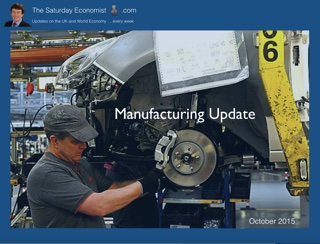 Gloomy data on manufacturing released by ONS … The latest data from the Office for National Statistics continue to present a gloomy outlook for the manufacturing sector. Output in August fell by 0.8% following a drop of -1.2% in July. We expect manufacturing output in Q3 to fall by 1% compared to the same period last year. For the year as a whole, we now expect growth of just 0.5% in the current year compared to growth of 2.7% last year. Next year we forecast a slight improvement with growth up by 1.5%. That’s more or less in line with the long run [fifty year] average. The march of the makers will be unable to rebuild the workshop of the world any time soon and won’t hit the government £1 trillion export target by 2020. So why is the performance of the manufacturing sector so dismal? In the UK, retail sales are booming with sales volumes up by almost 5% in the year to date. Car sales are soaring with registrations up 7% year on year. The housing market is experiencing strong growth with the volume of transactions up by 6% in August following growth of 15% last year. Consumer confidence is improving, earnings are increasing and the jobs market presents little threat to household prospects in the months ahead. Manufacturers should be benefitting from sales of construction and home products but are they? Internationally the picture is less attractive … Internationally the picture is less attractive. World trade limps along despite a recovery in the US and Europe. Prices are undermined by low energy and commodity prices. Margins are under pressure as the trade weighted value of sterling is up by 5% compared to last year. The “Sterling Effect” is much exaggerated. The pound was up by almost 7% in 2014 compared to prior year and manufacturers still managed growth of almost 3% in the year Sectoral Analysis holds the clue .. In our research we analyse over 50 sectors within the manufacturing sector. Not all sectors tell the same story. Some sectors continue in a process of long term decline, notably tobacco, textiles clothing, computers, electrical equipment, optical equipment and consumer durables. The housing market is bringing benefits to construction products including cement and plaster and also leading to a rally in furniture output to levels last experienced pre recession. Other sectors especially transport equipment are experiencing strong growth. Transport equipment output continues to expand in the areas of wheels, wings and water i.e. Marine, Motor and Aerospace activity. Capital goods have also enjoyed strong growth with a big recovery in engineering and allied industries. The food and beverages sector to experience steady and strong growth. Meat, fish and dairy products have experienced a strong rally since 2009. Output in the dairy sector has increased by 50% over the last six years. Bakery products are up by 25% from 2009 but have experienced a set back into 2015, possible victims of the Mary Berry home baking craze. Beverage sales are up especially the manufacture of alcohol products. Soaps, detergents, polish and perfumes remain as one of the great performers in the sector with steady growth through the recession The manufacture of wood, rubber, paints and paper products demonstrate a shock to output in 2008/9 with little recovery to date. In the chemical and petrochemical sectors, the shock to output is also evident with a limited recovery so far. The manufacture and processing of basic metals remains flat with a continued setback in casting and fabrications. The manufacture of weapons and ammunition remains some 40% below the pre recession high. Summary … Overall manufacturing output remains some 7% below the pre recession peak and in line with levels experienced at the end of 1989. We expected too much from manufacturing in the rebalancing agenda. The average rate of growth since 1950 has been just 1.5% hence the share of output decline in an economy growing at 2.5% plus. Hopes for a manufacturing rally were rhetoric without reason. The prospect of re shoring was illusory as the plans for Jaguar Land Rover to expand output overseas demonstrate. The UK does not have a revealed comparative advantage in manufacturing to stimulate export growth. The balance of payments trade in goods will continue to deteriorate despite some improvement this year from international energy, oil and commodity prices. The UK does have a varied manufacturing base, with real strengths in transport, food, drink and capital goods. The sector can only achieve so much in international trade and will offer so little to the rebalancing agenda. We should not expect too much from our manufacturers. JKA October 2015 For a copy of The Manufacturing Update October edition check out the download button on the home page.
0 Comments
Leave a Reply. |
The Saturday EconomistAuthorJohn Ashcroft publishes the Saturday Economist. Join the mailing list for updates on the UK and World Economy. Archives
July 2024
Categories
All
|
| The Saturday Economist |
The material is based upon information which we consider to be reliable but we do not represent that it is accurate or complete and it should not be relied upon as such. We accept no liability for errors, or omissions of opinion or fact. In particular, no reliance should be placed on the comments on trends in financial markets. The presentation should not be construed as the giving of investment advice.
|
The Saturday Economist, weekly updates on the UK economy.
Sign Up Now! Stay Up To Date! | Privacy Policy | Terms and Conditions | |
 RSS Feed
RSS Feed